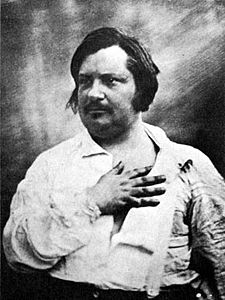Honore de Balzac 1799 - 1850
August 13, 2008
 Honore de
Balzac 1799 –
1850 was a French novelist and playwright. His magnum opus was a
sequence of almost 100 novels and plays collectively entitled La
Comédie humaine,
which presents a panorama of French life in the years after the fall of
Napoleon
Bonaparte
in 1815.
Honore de
Balzac 1799 –
1850 was a French novelist and playwright. His magnum opus was a
sequence of almost 100 novels and plays collectively entitled La
Comédie humaine,
which presents a panorama of French life in the years after the fall of
Napoleon
Bonaparte
in 1815.
Honore de Balzac was a patient of Samuel Hahnemann in Paris (? Samuel Hahnemann and Klemens Wenzel Prince von Metternich in Honoré de Balzac). Balzac was also a patient of David Ferdinand Koreff.
Honoré de Balzac was influenced by Emanuel Swedenborg.
He is renowned for his multi faceted characters; even his lesser characters are complex, morally ambiguous and fully human.
Inanimate objects are imbued with character as well; the city of Paris, a backdrop for much of his writing, takes on many human qualities. His writing influenced many famous authors, including the novelists Marcel Proust, Emile Zola, Charles Dickens, Gustave Flaubert, Marie Corelli, Henry James and Jack Kerouac, as well as important philosophers such as Friedrich Engels. Many of Balzac’s works have been made into films, and they continue to inspire other writers.
An enthusiastic reader and independent thinker as a child, Balzac had trouble adapting himself to the teaching style of his grammar school. His willful nature caused trouble throughout his life, and frustrated his ambitions to succeed in the world of business.
When he finished school, Balzac was apprenticed as a legal clerk, but he turned his back on law after wearying of its inhumanity and banal routine. Before and during his career as a writer, he attempted to be a publisher, printer, businessman, critic, and politician. He failed in all of these efforts. La Comédie Humaine reflects his real-life difficulties, and includes scenes from his own experience.
Balzac suffered from health problems throughout his life, possibly due to his intense writing schedule. His relationship with his family was often strained by financial and personal drama, and he lost more than one friend over critical reviews. In 1850, he married Ewelina Ha?ska, his longtime paramour; he died five months later.